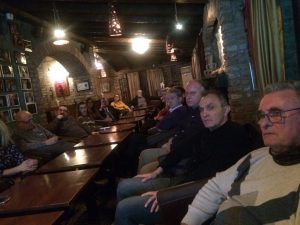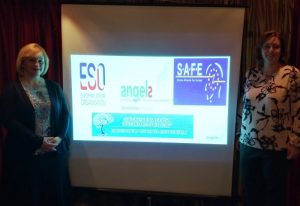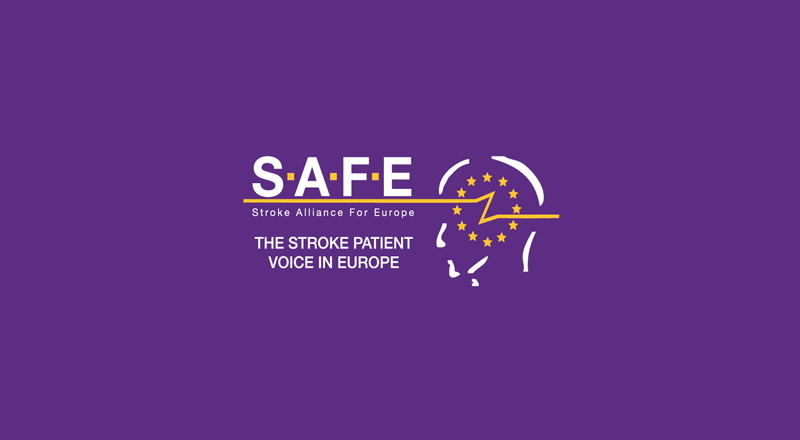Angels Initiative builds a global community of stroke centers and stroke ready hospitals, working each day to improve the quality of treatment for each patient with stroke.
Written by Prof. Dr Anita Arsovska and Dr Maja Bozhinovska-Smicheska
26.02.2018, Skopje, R. Macedonia– Association for a fight against stroke ,,Stroke” Macedonia in collaboration with University Clinic of Neurology organized a scientific meeting ,,Angels Initiative in Macedonia – next steps” on Friday, 23rd February. Meeting was attended by 50 medical specialists from all over Macedonia.
The Director of Macedonian University Clinic of Neurology, Skopje Ass. Dr Ivan Barbov, opened this meeting with an introductory lecture about Angels initiative project in Republic of Macedonia. He introduced the audience with the basic principles on which this project was based. Dr Barbov noted that, according to the World Health Organization (WHO), 17 million people per year suffer from a stroke and every 30 minutes a stroke patient who could have been saved, dies or is permanently disabled, because they were treated in the wrong hospital. Angels Initiative mission is to increase the number of patients treated in stroke ready hospitals and to optimize the quality of treatment in all existing stroke centers.
Angels Initiative builds a global community of stroke centers and stroke ready hospitals, working each day to improve the quality of treatment for each patient with stroke. The support of the Angels Initiative means supporting life. What are the practical steps that we in Macedonia can take in this direction?
1. Make a list of all health facilities where patients with stroke are treated
2. They can be registered on the Angels website
3. Then register in the Res Q register

The audience at Angels Initiative meeting in Skopje, Macedonia
Patients with stroke are entered in this register and it will as a database from which we can extract many useful information (number of patients, risk factors, application of i.e. thrombolysis, treatment outcome, etc.). Since last year, the Clinic of Neurology has been actively involved in this registry, and the goal is to involve more hospitals in our country. The purpose of the Angels Initiative is to achieve the number of 1500 stroke ready hospitals until May 2019. According to the number of inhabitants of the Republic of Macedonia. Macedonia (2,081,000), the estimated number of acute brain strokes in the Republic of Macedonia. Macedonia (4,495) per year and the calculated incidence of stroke / 100,000 inhabitants, the number of necessary centers for stroke in R. Macedonia is -10.
Then Dr Maja Bozhinovska-Smicheska from the Special Hospital ,,St. Erasmo” Ohrid and President of the Association for a fight against stroke ,,Stroke”, elaborated the following procedures and steps that should be undertaken for the implementation of this initiative, giving guidance on the practical implementation of Angels in Republic of Macedonia. In her lecture, Dr Bozhinovska-Smicheska, among other things, presented the necessary minimum criteria (according the European Stroke Association) that should be fulfilled for stroke ready hospital:
1. Percentage of patients with acute ischemic stroke treated with intravenous thrombolysis with door-to-needle time <60 min …>50%.
2. Percentage of recanalization of the procedure …5% min-15% target
3. Percentage of diagnostic imaging methods (KTM or MRI) in any patient suspected of stroke … 85% min
4. Percentage of patients with ischemic stroke with antiagregant therapy … 85% min.
5. Percentage of patients with ischemic stroke and atrial fibrillation, with prescribed anticoagulant outpatient therapy ……… 85% min
6. Percentage of patients with stroke with screening for swallowing disorders …85%min.
She also gave a description and explanation of ESO recommendation on establishing a stroke unit and center and best protocols and tools for work in this units by ESO and AHA/ASA, numbers that determine quality in stroke units and centers, recommended time frames, and examples from Helsinki model. She invited all to include into Res Q register explaining benefit from it.
The necessity of cooperation was emphasized with the colleagues of emergency medical care, for faster transfer of patients with stroke in the appropriate health institution and significance of prenotification, as well as the procedures and diagnostic pathways that should be followed for faster diagnosis and possible application of intravenous thrombolytic therapy. Helsinki Model was presented as well as the opportunity that Angels Initiative offers: educational opportunities through lectures by top experts and professors in the field of stroke, video education and webinars, educational materials, interaction and networking, video examples from practice, training and virtual simulation. The Angels Initiative also offers the education and certification of nurses, through 20 modules and tests and the application of the so-called. FeSS protocol was also discussed.

Prof. dr Anita Arsovska and Dr Maja Bozhinovska-Smicheska at Angels Initiative meeting in Skopje, Macedonia
Prof. Dr Anita Arsovska from the University Neurology Clinic and member of the Board of the Stroke Alliance for Europe (SAFE) spoke about the Burden of stroke Report, the indicators of the quality of stroke management, and the latest recommendations from the American Heart Association and American Stroke Association related to the use of intravenous thrombolysis and mechanical thrombectomy in patients with acute ischemic stroke. The recommendations of 2018 updated the 2013 recommendations that were published before the results of the six positive studies of mechanical thrombectomy with “early window” (MR CLEAN, ESCAPE, EXTEND-IA, REVASCAT, SWIFT PRIME, THRACE) were published, this studies were performed in 2015 and 2016. Furthermore, in the last 4 months, 2 studies (DAWN and DEFUSE 3) showed a clear benefit from the “extended window” of mechanical thrombectomy for certain patients with an acute ischemic stroke, with a large blood vessel occlusion in the anterior circulation that could be treated for a period of 16-24 hours.
The latest recommendations again confirm that:
– the benefit of i.v. tissue plasminogen activator thrombolysis is time-dependent;
– treatment in the appropriate patients should be initiated as soon as possible (even in patients who are possible candidates for mechanical thrombectomy), and
– thrombolysis should be given to all appropriate patients with acute ischemic stroke over a period of 3 hours from the onset of the symptoms and in a select group of appropriate patients with acute ischemic stroke (based on the exclusive criteria of the ECASS III study) for a period of 4.5 hours from the onset of symptoms, centers should try to reach the door-to-needle time of < 60 minutes at ≥50% of patients with stroke treated with IV thrombolysis.
Before the onset of intravenous thrombolysis, in most patients, the only tests needed are glicemia and plain CT. There is no need to wait for INR results, partial thromboplastin time, and platelet counts if there is no suspicion of previous coagulopathy. The centers should strive to make computerized tomography of the brain within 20 minutes of arrival in ≥50% of patients with acute ischemic stroke who are candidates for intravenous thrombolysis or mechanical thrombectomy. For patients who are potential candidates for mechanical thrombectomy, an urgent CT angiogram or MR angiogram is recommended (to see occlusion of large vessels), but these trials should not delay treatment with intravenous thrombolysis if indicated. Inclusion criteria for treatment with mechanical thrombectomy are patients ≥18 years, with a minimum disability prior to occurrence of stroke with symptomatic occlusion of the internal carotid artery or proximal occlusion of the median brain artery, have a NIHSS score ≥6 with an ASPECT score of ≥6 on computerized tomography of the brain and are preferably treated in a period 6 hours from last seen healthy.
There is no need for CT / MR perfusion for these patients. In selected patients with acute ischemic stroke over a period of 6-24 hours from the last seen healthy who have evidence of high blood vessel occlusion in the anterior circulation and meet the criteria of DAWN or DEFUSE 3 studies, CT / MR perfusion is recommended help determine whether the patient is a candidate for mechanical thrombectomy. In selected patients with acute ischemic stroke for a period of 6-16 hours from the last seen healthy, having a large blood vessel occlusion in the anterior circulation and meeting the other inclusion criteria of DAWN or DEFUSE, mechanical thrombectomy is recommended. In selected patients with acute ischemic stroke over a period of 6-24 hours from last seen healthy which have a large blood vessel occlusion in the anterior circulation and meet other DAWN inclusion criteria, mechanical thrombectomy with stent Ritterver is reasonable.
In conclusion, Prof. Arsovska stressed that intravenous thrombolysis is and remains the standard in the treatment of acute ischemic stroke. The latest studies underway (EXTEND (International): Extending the Time for Thrombolysis in Emergency Neurological Deficits (International) and ECASS 4: European Cooperative Acute Stroke Study-4: Extending the time for thrombolysis in emergency neurological deficits: will show whether the time therapeutic window will be able to expand to 4.5-9 hours.The planned studies: SWIFT-DIRECT, MR CLEAN-NO IV, RACECAT may give an answer to the current question, should the patient with acute ischemic stroke be taken to a health facility with the possibility of mechanical thrombectomy or the nearest hospital with the possibility for the application of intravenous thrombolysis? There is a need for randomized studies that will compare direct mechanical thrombectomy with brading therapy in patients with high blood vessel occlusion who have immediate access to endovascular therapy.
After completing the lectures, neurology specialists from the country have developed an interesting and rich discussion, where colleagues presented their own experience regarding the application of intravenous thrombolysis and the problems they face in everyday practice. It was discussed about the possibility of reviving mechanical thrombectomy in routine practice, certainly in cooperation with colleagues in neurosurgery, cardiology and neuroradiology.
The attendees welcomed the Angels initiative and agreed that it is necessary to enter data in the ResQ registry so that we can see the real situation and take the necessary measures to reduce the number of strokes in our country and to reduce the consequences it has causes not only the patient, but also the family and the whole society.





